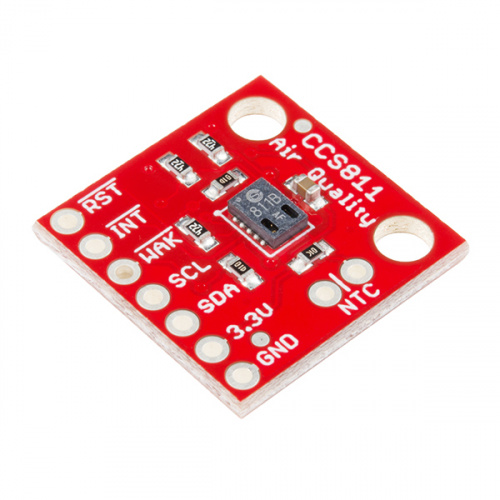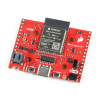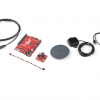Ever since the SparkFun Air Quality Breakout was released I've wanted to find a fun project for this pocket air quality sensor. Turns out that a perfect opportunity was right in front of me. I recently had a roommate move out of my place, so I decided to take readings while I "cleaned" the room. This certainly wasn't a controlled scientific experiment by any means, but it was interesting to see the different readings during the cleaning process. Keep in mind that this sensor measures TVOCs (Total Volatile Organic Compounds), so before we begin, here is a quick definition from Indoor Environment Group of the Lawrence Berkeley National Laboratory:
Researchers, and those who investigate indoor air quality problems, sometimes measure and report "total volatile organic compound" or "TVOC" concentrations. The term TVOC refers to the total concentration of multiple airborne VOCs present simultaneously in the air. TVOC methods do not measure all VOCs in the air, but a subset of VOCs that are expected to be present. Measuring TVOC concentrations is less expensive than measuring the concentrations of many individual VOCs. However, there are two main limitations to TVOC measurements. First, different TVOC measurement methods can yield substantially different TVOC concentrations and the differences between measurement methods will depend on the mixture of VOCs present. Secondly, the toxicity and the odor thresholds of individual VOCs within the VOC mixture may differ by orders of magnitude; therefore, the total concentration is not likely to provide a useful measure of total toxicity or total odor level. In general, TVOC measurements in buildings have not been useful in predicting health effects.
After reading about TVOC readings I knew not to make any grandiose statements about the measurements I would get and any relation they may have to health effects. This would essentially become an experiment based on curiosity and nothing else. With that being said, let's begin.
The Empty Room
The completely empty room measured 12'x12'x8'. Before my roommate moved out I told him not to do any cleaning of any sort. I kept the windows and doors shut to try to prevent any air flow. Neither the A/C nor the furnace were on, and I placed the sensor in the middle of the room. For each different step I would let the sensor sit for 20 minutes and then take the reading.
Original Reading
After the recommended burn-in time of 48 hours and a run-in of 20 minutes (you must allow 20 minutes for the sensor to warm up and output valid data), I established a base reading of 161 TVOCs.
Step 1: Vacuum
After a double vacuum session, the TVOC level actually came up a bit to 136 TVOCs. I did film while I vacuumed and noticed that the readings fluctuated up and down. Possibly due to me moving around and creating air flow or the vacuum could have been kicking up some dust, so to speak.
Step 2: Clean the Windows
This one is interesting because I used a "naturally derived" glass cleaner and still my reading shot up to 897. According to the National Pollutant Inventory, Ethanol (which is the active solvent in the window cleaner) is considered a VOC.
Step 3: Dusting
For this step I dusted the window seals, baseboards and the top of the door trimming. I sprayed a standard dusting spray (not naturally derived) on a rag several times throughout the process but tried not to let too much of the spray out into open air. The sensor had a readout of 1156 TVOCs. The max readout on this sensor is 1187, so I feel pretty safe saying this probably wasn't the ideal breathing situation, and I was starting to feel like I really needed some fresh air.
Step 4: Air Freshener
Not that the room wasn't already fragrant enough from the window cleaner and dusting spray, but I wanted to see what a few waves of Air Freshener might do to the readings. I have to say I fully expected the sensor to reach its max of 1187, but the opposite actually happened. Within one minute of spraying, the reading was down to 575, and it eventually settled at around 436 TVOCs.
Step 5: Air Purification Remedies
Before I simply opened the windows, I wanted to try some different air cleansing methods to see if anything could give fairly quick results. The first thing I tried was running an air purifier for 20 minutes. The readings went from the mid-500s to 354. I'm not sure if this actually did a whole lot of good or if it was simply because some of the previous cleansing products had settled.
The next thing I tried was a diluted mixture of tea tree oil, which is said to purify the air due mainly due to its antiseptic and fungicidal properties. The beginning reading in the mid-300s went down to 297 TVOCs after another 20 minutes. Again, my guess is this was just due to settling.
Next up was trying out the magical powers of my Himalayan salt lamp. I made sure it was warmed up for a while before I brought it in so that all the negative ions could go capture all those pollutants (as some claim they can do). However, after another 20 minutes there was nothing substantial when the reading ended at 268 TVOCs.
The last experiment was to see just how fast some trusty plants could swallow up a common household VOC — CO2. I brought in eight small plants and surrounded the sensor with them for yet another 20 minutes. I didn't expect to see much of a difference with only leaving these around for 20 minutes, and I was correct. The TVOC reading only came down to 241.
Step 6: Fresh Air Time
Now it was time to open the windows and the door and turn on a fan. Within a couple minutes, the sensor was nearly to 0. Even with some lingering scents from the products used, simply getting some fresh airflow to the room made an instant difference.
What Did We Learn?
Probably not a whole lot. I think we knew that most of the household cleansing products we use probably aren't the best for us to breath in. It was fun to put some numbers to them, though. One thing that did surprise me was just how fast opening windows and getting some airflow in your home instantly improved the air quality (in terms of TVOCs). Open your window and get outside, people!
Have you experimented with an air sensor? Tell us about it in the comments below.















As far as the drastic improvement from opening the windows... What sort of environment is your apartment building in? Rural? Urban? I wouldn't be surprised that one would get drastically different results from opening a window out in the middle of nowhere vs. in the middle of a major urban center.
That's a great point, my home is north of Denver in the suburbs. Pretty clean air for the most part.
Can I use the CCS811 Sparkfun with Raspberry Pi3 B+?
Take a look at this tutorial and sub out the sensor we are using on that for the CCS811. If that doesn't help you out reach back out and I'll talk with someone who knows a little more than I do about this.
I extended the baseline example from the Sparkfun library to show the "APP firmware" of the sensor. All my 3 different CCS811 sensors, bought from different providers, had the "APP firmware" version 1.1.0 loaded. AMS in the meantime offers "Application firmware 2.0.0". So I extended the example even more to allow an "application firmware update" to that sensor. It is working only on a ESP32 and probably on a ESP8266 with the Arduino IDE because it needs the SPIFFS for the firmware file to be stored in. You can find the sketch in: https://github.com/RalfJL/CCS811FirmwareUpdate After the update the sensor is behaving pretty different than with firmware 1.1.0. My impression is that it is less volatile and does not report "gigantic" values as it did with version 1.1.0. My next step will be to have 2 sensors close by to see if the values match, or are close to each other. @Sparkfun: please feel free to add the upgrade code to your library. It is very close to what is described in AN0000370
About step 3..I am worried about the 1156 figure. I am using two Uhoo systems, and one of them is showing after warm up period(30 days) that 1156 figure and was and is showing it for two days. I tried the other Uhoo unit but that gives not that 1156 figures in the same room.. I wonder I did buy a bad product maybe something wrong with one of the units. The help desk tells me I have to wait a week at least, but I have my doubts about. The other measurements are ok of the unit, but only that 1156 TVOC figures worries me(and my 299 Euro I paid for the unit)